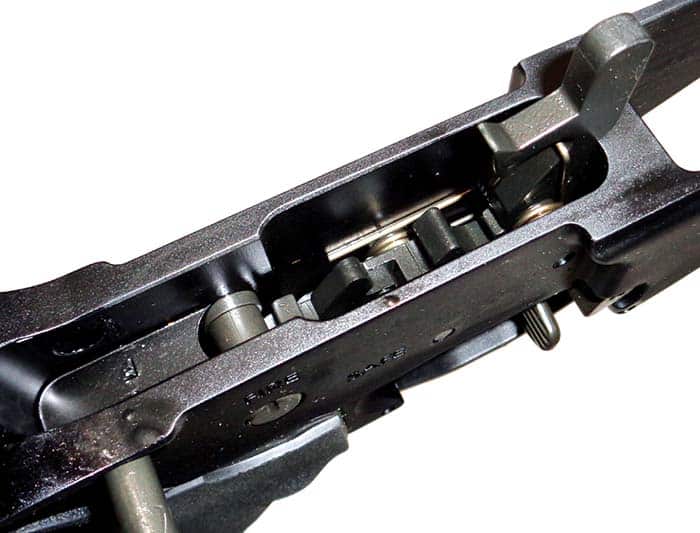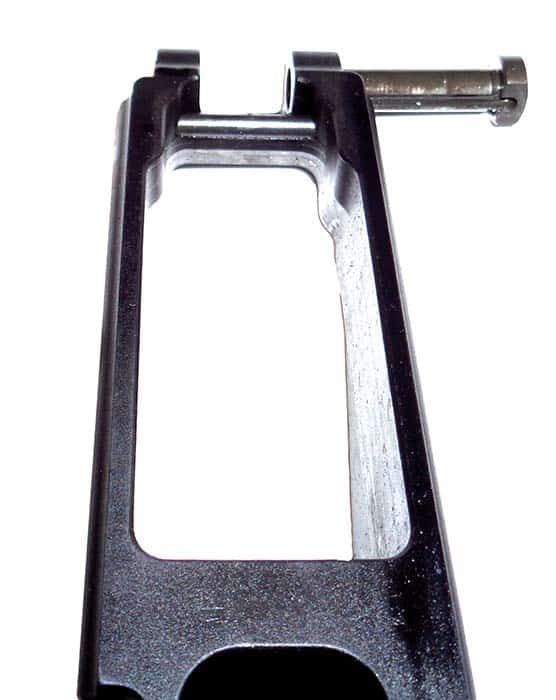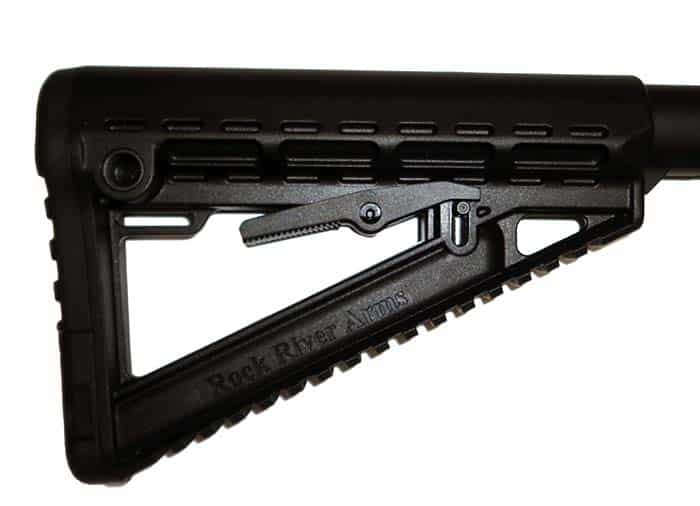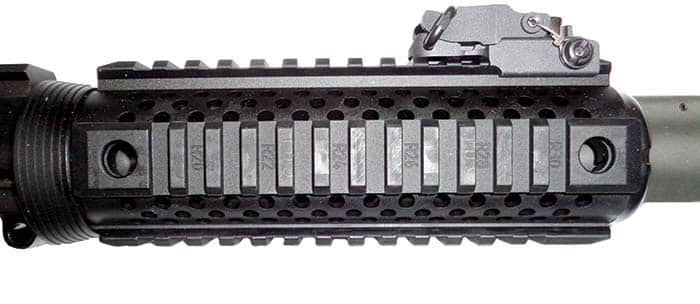The rifle submitted to SAR for test and evaluation is the LAR-47 Delta series, which included the MIL-STD-1913 quad rail.
By Christopher R. Bartocci
Over the years, there have been several manufacturers who have attempted to make (and some that still make) AR-platform rifles chambered in the 7.62x39mm caliber. It would only make sense since the M43 Soviet round has proven its mettle all over the globe. There are many out there who love the power of the 7.62x39mm round, but not the AK-series rifle that shoots it. Let’s face it, the AK is not known for its accuracy, human engineering or quality. Saying that, the rifles are nearly indestructible in terms of reliability. But putting that round into an AR-platform takes care of the accuracy, human engineering and quality issues. Reliability, well, the AK will still have that edge. In the commercial market, 7.62x39mm is inexpensive for target shooting purposes and is capable of taking down medium-size game, such as deer. Ballistics are quite similar between 7.62x39mm and the ever popular 30-30 Win cartridge.

The biggest problem encountered in the industry with trying to put the 7.62x39mm cartridge in the AR-platform is the magazine well/magazine. The taper of the 7.62x39mm cartridge case is significantly more than that of the 5.56x45mm cartridge case. That causes a significant difference in the shape of the cartridge stack in the magazine. The “banana” appearance of the AK magazine is not designed for cosmetics, it’s shaped that way because of the way the cartridges stack in the magazine due to the taper on the cartridge case. When these rounds are put into the straight magazine of the AR family of weapons, the rounds tend to nose dive below the barrel extension or even in the magazine itself. Several companies have worked on this throughout the last 30 years or so. In this author’s opinion, nobody has been able to make a combat reliable 7.62x39mm magazine that will fit into a standard AR-type receiver. With all of this failure, why keep trying? Reed Knight of Knight’s Armament was the first to remedy this problem with the development of the SR-47. At the request of SOCOM, a couple of the industry partners developed rifles to shoot this caliber. Reed Knight changed the magazine well to take the standard AK magazine. From a logistical standpoint, it made perfect sense. Proper feeding from a combat tried and proven magazine (in a weapon the military would be familiar with) would give much more flexibility than the AK series. The soldier would be able to pick up ammo from the enemy on the battlefield and use the magazines and ammo in his rifle if resupply was not imminent. After the designs were shown to SOCOM they said thank you, ran some tests and then dropped the program. Reed Knight never put his SR-47 into production, but people saw what he did and saw the merits. There are now a few companies out there that are manufacturing lower receivers to accept the standard AK magazine including MGI (Hydra), CMMG MK-47 MUTANT and the Rock River Arms LAR-47.

At the 2012 SHOT Show, Rock River Arms showed the first prototypes to the industry. It would not be until early- to mid-2014 that they would ship the first rifles to dealers. The LAR-47 is a different rifle than what has been seen in the past. The upper and lower receivers are both designed specifically for the LAR-47. The lower accepts the AK-type magazine. The upper is slightly wider to accept the wider magazine. Early prototype rifles were designed with receivers manufactured from solid billets of 7075 T6 aircraft aluminum. For the rifles to enter production, the receivers would be manufactured from forgings of 7075 T6 aluminum. Rock River Arms felt that forgings were the way to go for high volume production of the rifle.
The first model was the LAR-47 CAR A4. This is a basic model with an MSRP of $1,270. The LAR-47 CAR A4 weighs 6.4 pounds and has an overall length of 36 inches. Beginning in the rear of the rifle and moving forward, the CAR A4 is equipped with the standard Rock River Arms Tactical Stock, which is a branded version of the standard military stock. The receiver extension has six positions for the stock. The lower receiver is the LAR-47 lower with a standard A2-style pistol grip. There is no bolt catch on the LAR-47. This does not work well with the standard AK magazine follower. Safety lever is the standard left side and the trigger guard is an LAR-47 specific version of the Rock River Arms Winter Trigger Guard. The magazine release differs from that of the AK. It is much easier to use and it offers the shooter two different way to actuate the magazine release. First, the shooter can use his trigger finger to push inward on the release to disengage the magazine. The shooter can also use his thumb to disengage the catch while grasping the magazine. The trigger provided is a Rock River Arms Two Stage Trigger. The test and evaluation rifle broke at 5 3/4 pounds. There was little to no creep on the second stage. The power of the hammer spring was sufficient to fire the hardest Russian primers. This has become a challenge for some of the AR-platform rifles firing the 7.62x39mm ammo. Both Tula and WOLF ammunition were fired without any issues of light strikes.

The upper receiver is similar to the A4/M4 configuration. It has a flat top MIL-STD-1913 rail on top. The receiver has a forward bolt assist as well as a fired cartridge case deflector. The upper also features the standard ejection port cover. There is a new feature found on the upper receiver and bolt carrier: an indicator line on both. When aligned, there is a visual indication that the bolt is fully locked. If the indicator lines are not aligned, the bolt is not locked. According to Rock River Arms, this feature may be added to other product lines. The barrel is held on with a standard barrel nut with a Delta Slip Ring assembly. Standard single heat shield handguards are used on the CAR A4 model. The gas block has a MIL-STD-1913 rail on top and is held on by two bolts.
The barrel is manufactured from 4140 steel and button cut with a 1 turn in 10 inch right hand twist. The CAR A4 has a 16-inch barrel which is hard chromed. Although this is standard on most 5.56mm barrels, this is most important on these 7.62x39mm barrels due to the fact that there is still corrosive 7.62x39mm ammunition in circulation. The chrome plating assists with some corrosion resistance and also extends barrel life. The hard chrome-plated barrel is about 4 times as hard as the standard barrel steel. When asked if the bimetal Eastern Bloc ammunition prematurely wore the barrels compared to copper jackets, Rock River Arms claimed, “We have not worn any barrels out yet, so we cannot say with any certainty. Steel cased ammo is, in general, harder on the extractor (and to a lesser extent the chamber) and the sealants that often go hand-in-hand with steel cased ammo can have negative effects on the bore, gas system, and eventually the gas rings but proper cleaning and maintenance can go a long way to prevent that.”

The muzzle device is a standard A2-style compensator. The bolt and carrier are chrome plated. Designers at Rock River Arms designed it this way due to the corrosive nature of some of the 7.62x39mm ammunition still in circulation. They claim the chrome bolt and carrier help to offset this a bit by making them easier to clean and providing a protective layer over the actual bolt and carrier materials (bolt is Carpenter 158 and bolt carrier is 8620 tool steel).
The second model (the one sent to SAR for test and evaluation) is the Rock River Arms LAR-47 Delta Carbine. This rifle has a weight of 7.75 pounds and a overall length of 36.5 inches. There are three differences between this and the basic LAR-47 CAR A4. The first difference is the stock. Instead of the Tactical CAR stock, a Delta CAR stock is provided. This is a rather unique stock. There are two QD sling attachment points and a sling loop on the rear inside of the stock. On the lower tube of the sling is a MIL-STD-1913 rail for sling mounts or other accessories. On the lower part of the butt is a removable O-ring sealed cap for storage of batteries. The second difference is the pistol grip is a Ergo rubber grip. The third is a Rock River Arms two piece Quad MIL-STD-1913 rail. There are five QD sling attachment points. The vent holes are small so the shooter will not touch a hot barrel accidentally. The rifle comes standard with the Rock River Arms Two Stage Trigger. The MSRP is $1,545.
The third model is the Rock River Arms LAR-47 Tactical Comp. This differs from the CAR A4 because it has the Operator CAR stock. The ribbed butt plate can be slid downward, revealing two O-ring sealed battery compartments. There are four QD detachable sling points. The pistol grip is the Rock River Arms NSP Overmolded A2 grip. The rifle comes standard with the Rock River Arms Two Stage Trigger and the gas block is replaced with a Rock River Arms Flip Front Sight Gas Block Assembly. This assembly has an integral tactical rail in the location of the bayonet lug along with 3 sling swivels. The rail is the free floating Rock River Arms Quad aluminum handguard. MSRP is $1,500.

There are two newly introduced models in 2015. The first is the Rock River Arms Coyote Carbine. This rifle has an overall length of 38 inches and weighs 7.8 pounds. This differs from the CAR A4 in a few ways as well. The buttstock on this model is the Rock River Arms NSP stock and a Hogue rubber pistol grip. The rifle comes standard with the Rock River Arms Two Stage Trigger. There is a low profile gas block and a Rock River Arms Deluxe Extended Free Float handguard, which is rifle length. The muzzle device is the Smith Enterprises Vortex flash suppressor. MSRP is $1,740.
Second is the Rock River Arms X-Series X-1 Rifle, which uses a Rock River Arms Operator A2 or a Operator CAR stock and a Hogue rubber pistol grip. The muzzle device is a Hunter Muzzle Brake or a Rock River Arms BEAST. The rifle’s barrel is an 18 inch long, bead blasted, fluted stainless steel heavy barrel. The handguard is the TRO-XL Extended Length Free Float Rail with a low profile gas block. Also standard: the Rock River Arms Two Stage Trigger. This rifle has a weight of 8.2 pounds and an overall length of 39 inches. MSRP is $1,600 to $1,650.
The test & evaluation LAR-47 Delta was in excellent condition. Fit and finish were superb. The chrome plated bolt and bolt carrier is an excellent enhancement. The magazines tested were the Thermold magazine the rifle was supplied with and various Russian and East German steel magazines. A Soviet Bakelite and Chinese Bakelite were also tested. All went in and out of the magazine well without issue and locked securely. The rail was impressive in that it came with 5 QD sling mounting points including on the end of the bottom rail. While looking the rifle over, the only real critique this author could offer is the location of the charging handle. Most users of the M16/M4 series rifle only use the charging handle for initial loading and malfunction clearing. On all other reloads, the bolt catch is used. With the LAR-47, every time you want to reload you must un-shoulder the rifle, replace the magazine with a loaded one and then change your hand grip to retract the charging handle to load the rifle and then re-shoulder. If the charging handle was moved to the side of the bolt, same as the standard AK, time could be saved without having to un-shoulder and re-shoulder the rifle during reloads.

Prior to test fire, two things were added: rail protectors and an optic. The handguard is manufactured from aluminum. Without a vertical grip, those handguards tend to heat up quickly. Added to the handguards were Manta rail protectors on the 3:00, 6:00 and 12:00 positions. The Manta rails covers are not your typical rail protectors. They insulate the shooter’s hand from extreme temperatures caused by continuous firing. The material is so strong that if you hold a cigarette lighter to its material directly, the material will not burn. One of their sound suppressor sleeves was subjected to the extreme heat of a propane torch. The material never caught fire. There was some ash on the surface of the sleeve, which was shaken off, and the sleeve worked as designed. When most people look at a rail protector they think just that, a protector. The Manta rail protectors do much more. They will also hide an IR signature. The suppressor sleeve works so well that one could fire 100 rounds out of an M4 on fully automatic and hold the rifle bare handed by the suppressor sleeve.
The optic chosen for this rifle was just introduced at SHOT Show 2015 by D.I. Optical USA. This particular model is their EG1 prism gun sight. This sight is mounted on an A.R.M.S., Inc. #17 throw lever mount. The body is manufactured from billet of aircraft-quality 6061 T6 aluminum and anodized black. The intensity of the red dot is adjustable by the large knob on the left side of the sight. The knob is large enough for one to be able to operate with heavy gloves on. The T&E model is equipped with two glare-reducing rubber hoods. The sight has passed MIL-STD-810G testing and is submersible to 30 feet. The lens is 30mm in diameter with 1x magnification. 1 click of adjustment is 24mm at 100 meters (Dot Only) / 1 MOA. The dot size is 2.5 MOA. The overall dimensions of the sight are 48mm x 53mm x 62mm. The sight is night vision capable. The range of adjustment is 150 clicks. Adjustment for elevation and windage are made on the right side with a coin or screwdriver.
During firing, there were no misfires or malfunctions of any form. 500 rounds of WOLF 122gr FMJ and 100 rounds of Federal American Eagle 124gr FMJ were used. Testing was conducted at the Van Road Gun Range in Houston, Texas. Firing at 50 yards revealed a just under 1.5 group firing from a rest with the D.I. Optical red dot sight. The best groups were all made with the Federal American Eagle ammunition.
Anyone who loves the 7.62x39mm cartridge but isn’t fond of all of the lower accuracy and the human engineering of the AK family of rifles now has a choice in an AR-type rifle that fires the cartridge they like and is in a proper magazine for the caliber. The AR-based 7.62x39mm magazines have always been a weak point in the reliability of the gun. With the use of the standard AK magazine, that problem is solved. The price is comparable to most high-quality black rifles as well.
| This article first appeared in Small Arms Review V19N10 (December 2015) |











